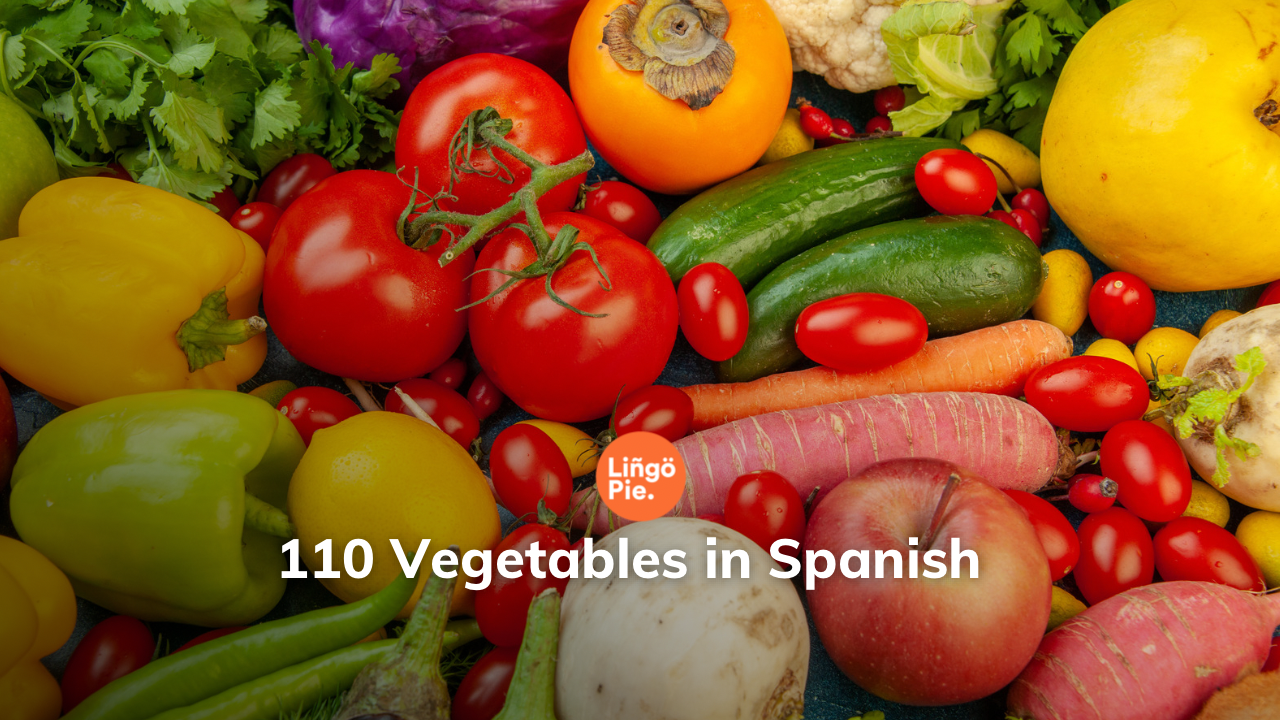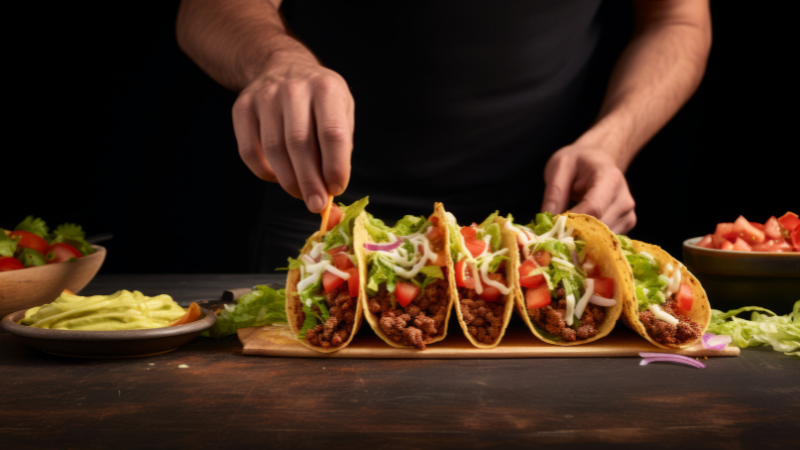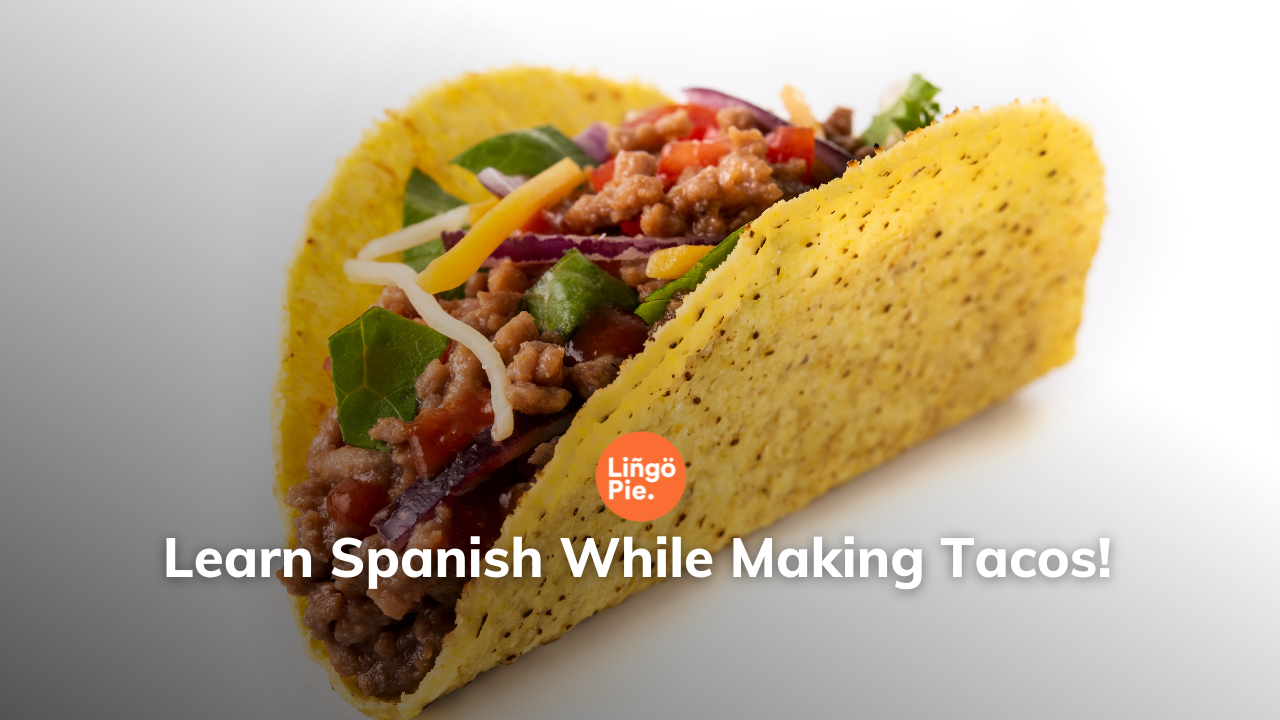Ever thought of learning Spanish while making tacos? Yes, everything can be a language learning material if you know how to benefit from it, and recipes are one of them!
In this blog post, we'll see how making tacos can help us learn the language while having a great time. By cooking and speaking Spanish, you'll see how tasty food and language learning go hand in hand. So, get into the kitchen and get prepared to make tacos and speak Spanish!

Table Of Contents
1. Learning a Language with Recipes
-Essential Spanish Vocabulary for Making Tacos
-Basic Ingredients
-Utensils and Equipment
-Cooking Verbs and Phrases
-Measurements and Quantities
2. Common Spanish Phrases Used in Recipes
3. Step-by-Step Taco Recipe In Spanish-English
4. Tips for Learning Spanish Through Cooking
5. Fun Facts About Mexican Cuisine
6. Final Words
7. Frequently Asked Questions
8. Learn Spanish Through TV Shows with Lingopie!
Learning a Language with Recipes
The connection between language and food is profound, serving as a gateway to understanding a culture's identity, history, and traditions. Food is not merely sustenance; it embodies a culture's values and beliefs, making it an invaluable tool for language learning. Exploring the culinary landscape of a language's native speakers offers insight into their daily lives, celebrations, and rituals, providing context and depth to language acquisition.
Moreover, cooking engages multiple senses, fostering a dynamic learning experience. As language learners chop, sauté, and savor ingredients, they immerse themselves in a rich sensory environment that enhances memory retention and comprehension. Tacos, with their vibrant array of flavors, textures, and aromas, epitomize this fusion of language and food.
As an iconic dish of Mexican cuisine, tacos offer language learners an ideal platform to explore essential vocabulary related to ingredients, cooking techniques, and cultural customs. From discussing the origins of corn tortillas to mastering the art of salsa-making, the journey of cooking tacos becomes a delicious and enlightening pathway to mastering the Spanish language.
Essential Spanish Vocabulary for Making Tacos
Here, you'll learn everything you need to know when following a Spanish taco recipe. From staple ingredients like tortillas, carne asada, and salsa to must-have utensils such as knives, pans, and cutting boards, we've got you covered!

Basic Ingredients
- Tortillas (tortilla)
- Carne asada (grilled meat)
- Queso (cheese)
- Salsa (sauce)
- Cebolla (onion)
- Tomate (tomato)
- Aguacate (avocado)
- Cilantro (cilantro)
- Limón (lime)
- Frijoles (beans)
- Sal (salt)
- Pimienta (pepper)
- Aceite (oil)
- Vinagre (vinegar)
- Azúcar (sugar)
- Harina (flour)
- Arroz (rice)
- Pasta (pasta)
- Leche (milk)
- Huevos (eggs)
- Queso (cheese)
- Mantequilla (butter)
- Ajo (garlic)
- Papas (potatoes)
Utensils and Equipment
- Cuchillo (knife)
- Tenedor (fork)
- Cuchara (spoon)
- Espátula (spatula)
- Batidor (whisk)
- Sartén (pan)
- Olla (pot)
- Tabla de cortar (cutting board)
- Colador (strainer)
- Horno (oven)
- Microondas (microwave)
- Licuadora (blender)
- Batidora (mixer)
- Tostadora (toaster)
- Parrilla (grill)
Cooking Verbs and Phrases
- Cortar (to cut)
- Picar (to chop)
- Mezclar (to mix)
- Batir (to beat)
- Revolver (to stir)
- Cocinar (to cook)
- Asar (to roast/grill)
- Freír (to fry)
- Hornear (to bake)
- Hervir (to boil)
- Enfriar (to cool)
- Servir (to serve)
- Probar (to taste)
- Agregar (to add)
- Escurrir (to drain)
Measurements and Quantities
- Taza (cup)
- Cucharada (tablespoon)
- Cucharadita (teaspoon)
- Gramo (gram)
- Kilogramo (kilogram)
- Litro (liter)
- Mililitro (milliliter)
Related blog posts:


Common Spanish Phrases Used in Recipes
- 500 gramos de carne picada - 500 grams of minced meat
- Dos tazas de arroz - Two cups of rice
- Tres cucharadas de aceite de oliva - Three tablespoons of olive oil
- Un diente de ajo picado - One clove of minced garlic
- Una cebolla grande, cortada en trozos pequeños - One large onion, chopped into small pieces
- Una lata de tomates triturados - A can of crushed tomatoes
- Sal y pimienta al gusto - Salt and pepper to taste
- Una ramita de romero fresco - A sprig of fresh rosemary
- Una taza de caldo de pollo - One cup of chicken broth
- Dos hojas de laurel - Two bay leaves
- Precalienta el horno a 180°C - Preheat the oven to 180°C
- En una sartén grande, calienta el aceite a fuego medio - In a large skillet, heat the oil over medium heat
- Añade el ajo picado y la cebolla a la sartén y cocina hasta que estén dorados - Add the minced garlic and onion to the skillet and cook until golden brown
- Agrega la carne picada y cocina hasta que esté bien dorada - Add the minced meat and cook until browned
- Vierte los tomates triturados y el caldo de pollo en la sartén - Pour the crushed tomatoes and chicken broth into the skillet
- Agrega la sal, la pimienta, el romero y las hojas de laurel - Add the salt, pepper, rosemary, and bay leaves
- Cocina a fuego lento durante 20 minutos, revolviendo ocasionalmente - Simmer for 20 minutes, stirring occasionally
- Sirve caliente y disfruta - Serve hot and enjoy!

Step-by-Step Taco Recipe In Spanish-English
Here is an easy and delicious taco recipe! We have a carne asada taco recipe with all the fresh and tasty ingredients. Let's get started!
Preparación de los ingredientes:
- Corta la carne asada en tiras delgadas. (Cut the grilled meat into thin strips.)
- Pica la cebolla y el tomate en trozos pequeños. (Dice the onion and tomato into small pieces.)
- Ralla el queso para tenerlo listo para servir. (Grate the cheese to have it ready for serving.)
- Corta el limón en cuñas para exprimir sobre los tacos. (Cut the lime into wedges to squeeze over the tacos.)
Cocinar la carne:
- Calienta una sartén a fuego medio-alto. (Heat a skillet over medium-high heat.)
- Agrega un poco de aceite y luego pon las tiras de carne asada en la sartén caliente. (Add a little oil and then put the grilled meat strips in the hot skillet.)
- Cocina la carne por unos 3-4 minutos por cada lado, o hasta que esté dorada y cocida. (Cook the meat for about 3-4 minutes on each side, or until golden brown and cooked through.)
Preparación de las tortillas:
- Calienta las tortillas en una sartén o en el microondas durante unos segundos. (Heat the tortillas in a skillet or microwave for a few seconds.)
- Envuelve las tortillas en un paño limpio para mantenerlas calientes mientras cocinas el resto de los ingredientes. (Wrap the tortillas in a clean cloth to keep them warm while you cook the rest of the ingredients.)
Montaje de los tacos:
- Coloca una porción de carne asada cocida en el centro de cada tortilla caliente. (Place a portion of cooked grilled meat in the center of each warm tortilla.)
- Añade cebolla picada, tomate, y cualquier otro ingrediente que desees. (Add chopped onion, tomato, and any other ingredients you like.)
- Espolvorea queso rallado sobre los ingredientes en cada taco. (Sprinkle grated cheese over the ingredients on each taco.)
Terminando los tacos:
- Exprime un poco de jugo de limón fresco sobre cada taco para darle un toque de frescura. (Squeeze a little fresh lime juice over each taco for a touch of freshness.)
- Añade salsa al gusto para un poco de picante adicional. (Add salsa to taste for some extra spiciness.)
- ¡Listo! Tus tacos están listos para disfrutar. (Ready! Your tacos are ready to enjoy.)
Tips for Learning Spanish Through Cooking
Practice pronunciation while cooking
- While following Spanish-language recipes, take the opportunity to pronounce ingredients, cooking techniques, and recipe instructions out loud.
- Pay attention to accents and intonation, mimicking native speakers as closely as possible.
- Practicing pronunciation while cooking not only reinforces language learning but also integrates it into daily activities, making it more natural and enjoyable.
Create a bilingual cooking journal
- Keep a journal where you write down recipes, cooking vocabulary, and any new Spanish words or phrases you encounter while cooking.
- Write the recipes in both Spanish and English, and make notes about any cultural insights or cooking tips you learn along the way.
- Review your journal regularly to reinforce vocabulary and track your progress in both cooking skills and language proficiency.
Watch Spanish cooking shows or tutorials for additional practice
- Tune in to Spanish-language cooking shows or search for online tutorials featuring native speakers demonstrating traditional recipes.
- Follow along with the chef as they explain each step in Spanish, pausing to look up unfamiliar words or phrases as needed.
- Pay attention to the chef's pronunciation, gestures, and expressions, as they provide valuable context for understanding the language in a culinary context.
Fun Facts About Mexican Cuisine
Corn: Corn, or maize, has been a staple in Mexican cuisine for thousands of years. It's not only a versatile ingredient used in tortillas, tamales, and pozole but also holds cultural significance as a sacred plant in ancient Aztec and Mayan civilizations.
Chocolate: The word "chocolate" originates from the Aztec word "xocolātl," and chocolate has a long history in Mexican culture. The ancient Aztecs prepared a bitter beverage made from cacao beans, which was considered a luxurious and ceremonial drink.
Mole: Mole, a rich and complex sauce made from a blend of chilies, spices, and chocolate, is one of Mexico's most famous culinary exports. There are many varieties of mole, each with its own unique flavor profile, such as mole poblano, mole negro, and mole verde.
Tacos: Tacos are perhaps Mexico's most iconic dish, enjoyed both in Mexico and around the world. While there are countless variations, from carne asada to al pastor to fish tacos, they all share a common love for simple, flavorful ingredients and fresh tortillas.
UNESCO Intangible Cultural Heritage: In 2010, UNESCO recognized Mexican cuisine as an Intangible Cultural Heritage of Humanity, acknowledging its importance in preserving cultural diversity and promoting social cohesion.
Final Words
To sum it up, learning Spanish by cooking tacos isn't just about mastering a new language—it's about enjoying the journey. From chopping veggies to sizzling meat, every step in the kitchen is a chance to immerse yourself in the language and culture of Spanish-speaking countries. So, as we finish up our taco adventure, remember that there are plenty more delicious dishes out there waiting to be explored.
Frequently Asked Questions
1. Are tacos Spanish or Mexican?
Tacos are traditionally a Mexican dish, with Americans using flour-based tacos and Mexicans eating corn-based tacos.
2. What does taco mean in Spanish slang?
In some Spanish-speaking countries, "taco" can have various slang meanings depending on the context and the region. One common slang meaning of "taco" in certain Latin American countries is "traffic jam" or "traffic congestion." For example, if someone says "Hay mucho taco en la carretera," they are saying "There is a lot of traffic on the road."
3. Do they eat tacos in Spain?
While tacos are not traditionally part of Spanish cuisine, they have become increasingly popular in Spain in recent years due to globalization and cultural exchange. In larger cities like Madrid and Barcelona, you can find Mexican restaurants and food trucks that serve tacos, burritos, and other Mexican dishes.
However, it's worth noting that the tacos you might find in Spain could have some differences compared to those in Mexico.
4. Who invented tacos?
Studies suggest that the taco as known in Mexican American cuisine was developed within the ethnic community, and its origins can be traced back to a combination of corn tortillas and pork sausage.
5. Why are tacos eaten on Tuesdays?
The association of tacos with Tuesdays comes from the popular phrase "Taco Tuesday." This phrase has been used in marketing campaigns, restaurant promotions, and pop culture references, particularly in the United States.
The idea behind Taco Tuesday is to offer discounts or specials on tacos, typically on Tuesdays, to attract customers to restaurants or food establishments.
Learn Spanish Through TV Shows with Lingopie!
Lingopie stands out for its unique approach to learning Spanish through authentic TV shows and movies with subtitles. This platform offers an immersive experience that helps improve listening comprehension and vocabulary in context. Its engaging and entertaining content makes language learning fun.
Lingopie is best suited for learners who enjoy learning from authentic media and want to enhance their listening skills in a relaxed environment. If you're looking to immerse yourself in Spanish or Mexican culture while improving your language skills, Lingopie is a great choice.
Download Lingopie from the App Store or Play Store now and get a FREE 7-day trial!





![6 Easy Ways To Learn A Language With ChatGPT [Guide + FREE Prompts]](/blog/content/images/2024/05/Learn-A-Language-With-ChatGPT-.jpg)

![30+ Modern English Slang Terms For Money [Guide]](/blog/content/images/size/w300/2025/06/Slang-term-for-money.jpg)
![5 Official Spanish Language Tests To Show Your Proficiency Level [Guide]](/blog/content/images/size/w300/2025/06/Spanish-Language-Tests.jpg)

![Why Memorizing Spanish Words Won’t Make You Fluent [Tips]](/blog/content/images/size/w300/2025/06/how-to-practice-spanish-vocabulary.jpg)